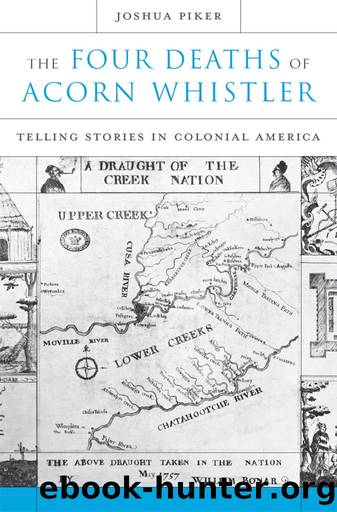The Four Deaths of Acorn Whistler by Joshua Piker

Author:Joshua Piker [Piker, Joshua]
Language: eng
Format: epub
Tags: History, Indigenous Peoples of the Americas, North America, United States, Colonial Period (1600-1775)
ISBN: 9780674075627
Google: JcsGeJa_avwC
Publisher: Harvard University Press
Published: 2013-06-01T01:48:29+00:00
IV
COLONIAL
ACORN WHISTLER WOULD have survived the 1752 crisis if it had not been for Thomas and Mary Bosomworth. Of course, it was Malatchiâs willingness first to accept the fiction of Acorn Whistlerâs guilt and then to push Acorn Whistlerâs kinsmen into planning the execution that sealed the Little Okfuskeeâs fate. But it was the Bosomworths who offered Acorn Whistler to Malatchi, and they did more than anyone else to ensure that Acorn Whistler would take the fall for the April 1 attack. In fact, the evidence suggests that Acorn Whistler was their preferred fall guy even before they accepted Glenâs offer to be agents to the Creeks. Mary knew that Glen wanted the heads of several of the Osochi attackers and that, as she told Glen in early June, âthe Satisfaction this Government thinks itself Honour bound to demand will be a very nice and difficult Point to be obtained.â Or, put another way, Mary knew that Glenâs other potential agents were right: the Creeks would not execute the men guilty of the April 1 attack, and it âwould not be very safe for an Agent to ask.â Mary and Thomas accepted the job anyway. They did so for two reasons. They were desperateâmore on that belowâand they knew that, while the Osochis were out of reach, the Creeks just might execute someone else. The Bosomworths, in short, left Charleston with Acorn Whistler in their sights.1
That fact explains why the Bosomworths were so threatened by reports that after Acorn Whistler fled Charleston on April 2 he stopped by to see them. There is no proof that such a visit took place, although the path from Palachucola (where Acorn Whistler left his horses in mid-March) to Lower Creek country (where Acorn Whistler met with Malatchi in mid-April) passed through the Bosomworthsâ trading post at the Forks; the Bosomworths were trading for deerskins that spring.2 Whether or not the Bosomworths met Acorn Whistler in April 1752âand my guess is that they did notâThomas was worried enough about the accusation that, in November 1752, he had the trader Moses Nunes sign an affidavit swearing that Acorn Whistler had told him that he ânever came near Mrs. Bosomworthâs House or spoke to herâ; a month later, John Spencer, another trader, signed a similar affidavit at Thomasâs request. And then, in January 1753, Thomas forwarded those affidavits to Glen, along with a letter that mentioned the âmany Slanders and absolute Falsehoodsâ concocted by his enemies, particularly âthat the Acorn Whistler . . . came to our House in Georgia.â3 Of course, by that point, the Bosomworths had succeeded in having Acorn Whistler executed, and so Thomas and Mary naturally wanted to beat back rumors linking them to him. The odd thing, though, is that the Bosomworths were beating back those rumors well before there was any reason to do soâwell before, that is, anyone was accusing Acorn Whistler of murdering those Cherokees.
Acorn Whistler was not publicly named as the mastermind of the April 1 attack until August 11.
Download
This site does not store any files on its server. We only index and link to content provided by other sites. Please contact the content providers to delete copyright contents if any and email us, we'll remove relevant links or contents immediately.
Madame Figaro by 27 Janvier 2023(587)
Wondrous Transformations by Alison Li(522)
William Tryon and the Course of Empire by Paul David Nelson(384)
If Wishes Were Coffee by Moore Michelle(341)
Against All Odds by Alex Kershaw(335)
Growing Up Underground by Steven Heller(334)
Jacob H. Schiff by Naomi W. Cohen(309)
Tabloid Love by Bridget Harrison(300)
From Loyalists to Loyal Citizens by Valerie H. McKito(281)
The Missionary of Wall Street: From Managing Money to Saving Souls on the Streets of New York by Stephen F. Auth(280)
Working on the Dock of the Bay by Michael D. Thompson(272)
Beware of Limbo Dancers by Reed Roy;(267)
Against All Odds: A True Story of Ultimate Courage and Survival in World War II by Kershaw Alex(266)
Bronx by Jerome Charyn(263)
Nephew by M.K. Asante(262)
Growing Up with Clemente by Peterson Richard;(259)
Crossing Highbridge by Waters Maureen;(259)
Pioneer Mother by Hillary Brown(256)
Studying Wisconsin by Martha Bergland & Paul G. Hayes(254)
